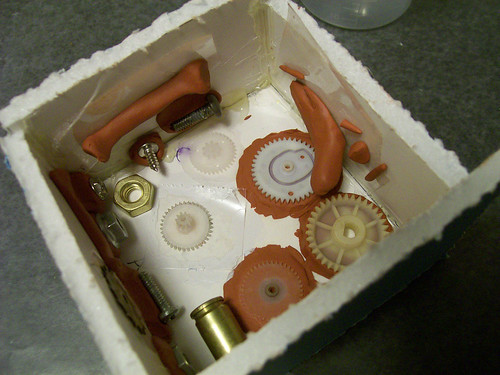Date : April 2009
Materials : Crayons!, Tap silicone RTV A & B (blue), lots of paper towers, tape, super glue, hot glue, poster board, clay, things that I wanted to cast
Tools : Saw, glue gun, candle, lighter, aluminum can, stir stick, disposable measuring cups
Finished Product:

Process:

Part A : Make the mold
To make the mold I cut out the box pieces from poster board and hot glued them together. I then just stuck things where they would fit- using two methods of attachment. A: clay! just stick it to the wall and stick the item into the clay. The end. B: Tape and glue! If I had double sided tape, this would be way easier... but I didn't... so I glued the non-sticky side down and stuck gears to the sticky side. After I was set, I mixed up the silicone mold as described on the side of the bottles. It's a mess, I wont detail the steps, they're already written down on the product. But *so* messy. Note: I used un-baked clay and it greatly slowed down the drying of mold touching it. The tape did as well, I believe.
Part B : Cast with crayons
Take your average soup can and wash it out & dry it. Throw some crayons in it. Light a candle. You can hold (with your fingers! How neat!) the can over the flame and melt the candles. Careful- the can get warm if your holding it near where you're warming it... experiment, you'll figure it out quick. Pour into molds! Tada! It dries super-quick for the shallow molds but deeper ones of course take longer- I just threw it in the fridge to speed up cooling down. I found that if I pour a bit, pushed it down with a stick and poured some more there was no structure issues and it filled the mold out more (for the gear teeth).
Thoughts :
Tape method works really well but still having difficulties... how now to prevent/remove the excess/overflow on top of the mold? Hmmm.. For things like the screw, rocking the screw back and forth a bit in the clay pre-pouring to allow the mold to inch up & around a bit more helped. The varied speeds of drying freaked me out, but now I know! The hand mold is difficult to remove, but none other are...
They're cool, but I'm not sure what to do with them... re-melting the gears is a pleasure to watch. Haven't tried to draw with them yet, so I don't know how sturdy they are. They respond well to modification via a heated needle after they've dried.
My current goal is to eat a computational machine. A thing that does something- I want to eat it. Consume it entirely. Ever seen the movie Ravenous? Sort of like that... I've given a lot of thought about how to consume circuitry, but I don't see how it'd work... so now I'm settling on a mechanical device... my goal to to better my skills with casting so I can buy food-safe silicone and create wonders... movable, edible, yummie wonders.... some day...
